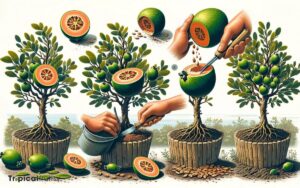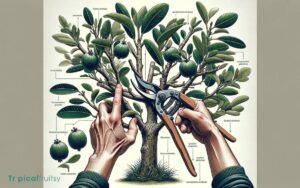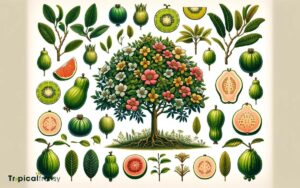Can You Espalier Feijoa Trees? Revealing the Truth!
Gardening enthusiasts often find themselves between a rock and a hard place when space is limited, yet the desire for fresh fruit grows strong.
Espalier, the ancient horticultural practice of training trees flat against a wall or trellis, offers a creative solution.
One can indeed espalier feijoa trees, turning them into living art that saves space while still yielding succulent fruit.
This technique requires selecting the right feijoa variety, setting up a sturdy framework, and understanding the nuances of planting and initial training.
Seasonal pruning becomes a choreographer’s dance, guiding the branches into the desired form.
With ongoing care and troubleshooting, even a novice gardener can nurture an espaliered feijoa to fruitful maturity, harmoniously blending form and function in their garden tapestry.
Key Takeaway
Understanding Espalier Basics
Espalier, the horticultural technique of training trees to grow in flat planes, can be applied to feijoa trees to optimize space and enhance accessibility.
This method involves meticulously shaping the tree’s branches along a sturdy framework such as a wall or trellis.
It’s not only aesthetically pleasing but also incredibly practical, especially in smaller gardens. Gardeners often choose espalier for feijoas to facilitate care and harvesting.
They start by selecting a young tree and then prune and tie the branches to the desired shape over several seasons.
This form of cultivation allows for easier pruning, spraying, and fruit picking due to the reduced height.
Now, let’s delve into the importance of choosing the right feijoa variety to ensure success in espaliering.
Choosing the Right Feijoa Variety
One must carefully select a feijoa variety that’s suited to espalier training for optimal growth and fruit production. Different varieties offer varying qualities such as size, taste, and hardiness, which can affect their suitability for espalier.
Here are some key considerations when choosing a feijoa variety for espalier:
- Growth habit: Look for varieties with a naturally upright and branching structure.
- Fruit size: Smaller fruits often handle the espalier form better.
- Pollination requirements: Some varieties are self-fertile, while others need a pollinator.
- Maturity rate: Consider how quickly the variety bears fruit.
- Climate compatibility: Ensure the variety thrives in your specific climate conditions.
Selecting the right variety not only ensures the health of the plant but also maximizes fruit yield. With the right variety in hand, one can then focus on setting up the espalier framework.
Setting Up Your Espalier Framework
Beginning with a sturdy support structure is crucial for espaliering feijoa trees. This provides the necessary foundation for training the branches.
Gardeners should space horizontal wires about 30 to 45 cm apart. This allows adequate room for growth and air circulation. It’s essential to secure anchor points firmly to withstand the weight of the tree as it matures and bears fruit.
Choose Support Structure
Typically, gardeners must select a sturdy support structure to properly espalier feijoa trees, ensuring it’s robust enough to handle the tree’s growth over time.
When establishing this framework, several options are available, each with its own benefits:
- Trellises: Offer flexibility and are easily installed against existing walls or fences.
- Wires: Can be tensioned between posts for a minimalist look and efficient space usage.
- Wooden Frames: Provide a traditional aesthetic and strong support for the branches.
- Metal Posts: Are durable and can withstand significant weight and weather elements.
- PVC Pipes: Serve as a cost-effective and versatile option, though they may require reinforcement.
Choosing the right support structure involves considering the space, the anticipated size of the mature tree, and the desired visual impact of the espalier.
Horizontal Wire Spacing
After choosing your support structure, you’ll need to space the horizontal wires correctly to provide optimal support for your feijoa tree’s growth.
The typical spacing between wires is about 45 to 60 centimeters (18 to 24 inches), which allows sufficient room for the branches to spread and receive sunlight.
It’s important that the wires are taut and firmly attached to your structure, as they’ll bear the weight of the branches as they grow. Use sturdy, galvanized wire to prevent rusting and ensure longevity.
The lowermost wire should be positioned approximately 30 centimeters (12 inches) above the ground to allow for ease of maintenance beneath the tree. Setting up your wires with precision will facilitate a successful espalier.
Next, let’s consider the importance of secure anchor points to maintain the integrity of your espalier framework.
Secure Anchor Points
Establishing secure anchor points is crucial when setting up your espalier framework, as they ensure the stability needed to support the growing feijoa tree. The framework must be robust enough to hold the branches in place while they grow and mature.
Here’s how to do it:
- Select durable materials, such as galvanized steel or heavy-duty wood screws, to withstand the elements.
- Use a drill for precise placement of screws or bolts into solid supports like walls or sturdy posts.
- Ensure that the anchor points are spaced evenly to distribute the weight of the branches.
- Check that each anchor point can hold the tension of the wires without giving way.
- Regularly inspect and tighten the anchor points as the tree grows and exerts more force.
With the anchor points set, it’s time to move on to planting and initial training.
Planting and Initial Training
When planting feijoa trees for espalier, gardeners should opt for young saplings as they’re more malleable for training. They’ll need to employ branch shaping techniques early on to guide the saplings’ growth in a flat, two-dimensional form.
This initial training sets the foundation for a successful espalier, so it’s crucial to start shaping as soon as the plant is established.
Selecting Young Saplings
Typically, gardeners choose young, healthy feijoa saplings for espaliering, as they’re easier to train during their initial growth stages.
To ensure the best start, one should be meticulous in selecting saplings that exhibit certain characteristics, which include:
- A straight and central leader stem to serve as the main vertical axis.
- Multiple lateral branches that can be shaped horizontally or diagonally.
- No signs of disease or pest damage, ensuring a robust start.
- A root system that’s well-developed but not pot-bound.
- Flexibility in the young branches, which is crucial for training without breakage.
The right sapling sets the foundation for successful espaliering. With the perfect candidate chosen, it’s time to delve into branch shaping techniques.
Branch Shaping Techniques
Once you’ve planted your feijoa sapling, it’s vital to start training its branches early on to adhere to your chosen espalier pattern.
Using soft ties, gently guide the young branches toward the support structure, ensuring you don’t damage the delicate growth.
Horizontal and fan shapes are common for feijoas, requiring you to select strong, laterally growing branches to form the primary lines of your espalier.
As the tree grows, you’ll need to periodically adjust the ties to minimize stress and avoid cutting into the expanding branches.
It’s crucial to maintain the form with minimal intervention, encouraging natural growth within the desired shape. This sets the stage for future growth, which will be meticulously maintained through seasonal pruning techniques.
Seasonal Pruning Techniques
During the dormant season, gardeners should prune their espalier feijoa trees to maintain shape and encourage healthy growth.
This task is vital for the health and aesthetics of the tree. Here’s how one can approach it effectively:
- Remove Dead Wood: Cut out any dead or diseased branches to prevent the spread of infection.
- Thin Out: Thin the tree to allow light and air to penetrate the canopy, which is crucial for fruit development.
- Shape: Trim back branches to reinforce the desired espalier pattern.
- Rejuvenate: Cut back old wood to spur new growth, which can lead to more fruit.
- Control Growth: Limit the height and spread of the tree to ensure it remains manageable and true to the espalier form.
These steps ensure a healthy, productive espalier feijoa tree.
Ongoing Care and Troubleshooting
After establishing a pruning routine, a gardener must also address ongoing care and common issues to ensure their espalier feijoa tree thrives throughout the year.
Regular watering is crucial, especially during dry spells, but it’s important to avoid waterlogging the roots. A balanced fertilizer applied in early spring can promote healthy growth. Mulching helps retain soil moisture and deters weeds.
Monitor for pests like aphids and scale insects, which can be controlled with horticultural oils or insecticidal soaps.
Diseases such as root rot and rust may occur; good air circulation and proper spacing between trees can help prevent these problems. If leaves yellow or drop, assess water and nutrient levels.
Lastly, ensure the support structure remains secure, adjusting ties as the tree grows.
Conclusion
Espaliering feijoa trees is like sculpting living history, an ancient technique bringing order to modern gardens.
By selecting the right variety, constructing a sturdy framework, and mastering seasonal pruning, gardeners can coax feijoa into artful productivity.
With diligent care and keen troubleshooting, these trees won’t only save space but also become a focal point of beauty and bounty.
It’s a blend of horticultural skill and creative expression, yielding delicious fruit and timeless elegance.






